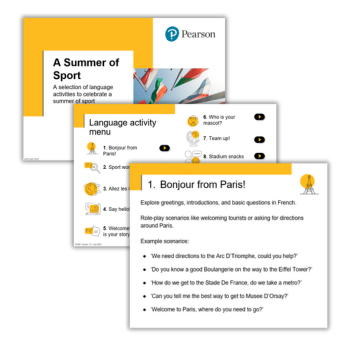GCSE languages – How to master the MFL hard-sell

Dr Amanda Barton reflects on why motivating students to learn a new language continues to be a challenge, and suggests some strategies for bringing them round…

- by Dr Amanda Barton
- Freelance writer and teacher educator at the University of Manchester

A long time ago (pre-pandemic), in a galaxy far, far away (Manchester), I used to tell PGCE students that being a modern languages teacher didn’t just involve teaching. You had to be a promoter, actively selling the subject to your hard-to-please clients.
Teachers of other subjects would no doubt argue the same come options time, but the recent slump in MFL uptake means that languages teachers are having to do a harder sell than ever.
BBC analysis carried out in 2019, based on the responses of 2,048 secondary schools, revealed that foreign language learning was at its lowest level in UK secondary schools since the turn of the millennium. The worst affected areas in England saw drops of between 30% and 50% since 2013 in the numbers taking language GCSEs.
MFL, Brexit and Ebacc
Unsurprisingly, the fallout from Brexit has been harsher on MFL than other subjects. The 2020 British Council Language Trends survey reported that Brexit has ‘cast a pall over languages’, with 58% of state schools in the survey reporting a drop in pupil motivation to study European languages.
You could be forgiven for thinking that the elephant in the staffroom – otherwise known as Ebacc might have acted as a counterbalance to this. MFL is, after all, one of the five constituent parts of said school performance measure, and the government remains committed to a target of having 75% of pupils be doing Ebacc subjects by 2022, and 90% by 2025.
Yet while the DfE claims the proportion of students studying a language has risen since the introduction of the Ebacc in 2010 (from 40% to 46% in 2018) the Language Trends survey shows there’s still a heck of a long way to go. In 2017, only 38.2% of pupils in the state sector were entered for the Ebacc. Among those entering four of the five components, 80.4% were missing the languages component.
So what can we do to stem the tide, and give students’ motivation to learn languages a much- needed boost?
Teaching Mandarin and Arabic
One way to start – though not necessarily a popular one – would be to look at the languages you offer. While we’ve seen a decline in the number of students opting for German and French, there has been a surge of interest in other languages, including Spanish, Mandarin, Polish, Russian and Arabic.
In 2001, just 2,500 students were taking languages other than French, German, Spanish or Welsh. By 2017, that number had risen to 9,400.
French remains the most popular language for now, but it’s been predicted that Spanish will overtake it by 2030, or even earlier if current trends continue. Rather than focusing on one language in-depth during the first three years of secondary school, there are arguments for building students’ broader understanding and interest in a range of languages and their cultural context.
One school in Derbyshire, Chapel-en-le-Frith High School, has increased take-up by offering KS3 students a taster of French, German and Spanish in a language awareness-style programme that cross-references other languages too.
The Language Trends survey recommends boosting motivation by revamping the KS3 curriculum to focus on those cultural aspects that are all too often neglected.
Single-sex classes?
Let’s put aside some time to explore with our students that age-old question, ‘Why do we have to learn a language?’ Now more than ever, that’s a perfectly valid question that demands an answer, especially given post-COVID travel restrictions and parents’ doubts regarding the practical value of learning other languages.
Students may be right in saying they’ll never use the foreign language they’re learning when on holiday – traditionally the main reason given for learning a new language – but they will stand to gain a whole range of transferable skills, especially in communication, that are highly valued in today’s post-Brexit economy.
The website Why Study Languages? highlights some of the many ways in which such skills are useful, with links to films, quizzes, advice on exams and revision, and a list of 700 reasons for studying languages.
A more radical strategy would involve reviewing the setting of your classes based on sex. Numerous research reports have found that GCSE uptake in MFL is much higher in all-boys and all-girls schools, compared to mixed schools. According to the 2020 Languages Trends survey, the average proportion of pupils taking a language at Y10 is 51%, compared with 74% at single sex state schools.
Some schools are currently experimenting with setting up single-sex MFL groups to tackle the demotivation that can set in during Y9. As my own doctoral research has indicated, if classes of this kind are paired with suitable teachers, they can lead to hugely positive outcomes.
Sadly, the main reason for students opting out of languages is something teachers can ultimately do little about – namely tough exams and severe grading.
Why would you opt to study a language when it’s so much easier to get a good grade in a different subject? For now, we can only hope that the government’s ongoing review into the GCSE system – which aims to reduce content and make the qualification fairer for all – will come to the rescue of a subject currently in peril.
4 ways to boost take-up of languages
1 | Engage the family
Involve parents and carers – who play a huge role in pupils’ subject choices – by sending home a languages quiz.
Include questions about where different languages are spoken, which are the world’s most widely spoken languages, and parents’ own experience of using other languages. Tap into people’s interest in learning a language during lockdown by inviting parents to taster classes.
2 | Meet students where they are
Remember that MFL can be scary for self-aware teenagers. Giving the department a Japanese or Norwegian taster lesson, and feeding back on how staff felt during the lesson, can be helpful in devising strategies that are less threatening to pupils.
3 | Think big
Once travel becomes possible again, organise a visit abroad, even if it’s just a day trip. Failing that, an intensive language day in school can be just as effective.
This could involve taking a whole year group off timetable to take part in activities conducted in a range of languages, including heritage languages. Recruit some trainee teachers to help out, and ask your canteen to serve dishes from other countries.
4 | Think small
Tell pupils a joke: One day, a mouse spots a packet of biscuits on the kitchen table. As soon as the cat goes into the garden, he ushers his baby mice into the kitchen. They’re half way across the floor when the cat suddenly reappears.
Quick as a flash, and in his loudest voice, the mouse yells, ‘Woof! Woof!’ Terrified, the cat races back outside.
The mouse turns to his babies and says, ‘So, children – now you can see why it’s always worth speaking a foreign language…’
Dr Amanda Barton is an educational consultant and freelance writer; follow her at @amandabook2.










